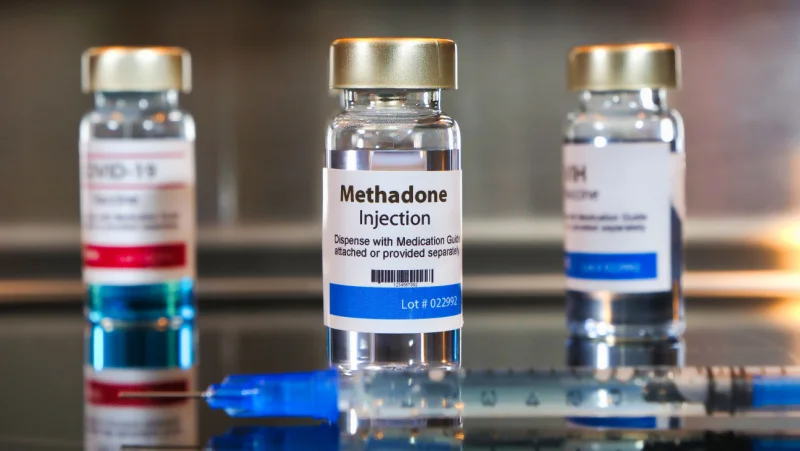Methadone Addiction: Symptoms, Treatment, and FAQs
Methadone is one of the most effective and commonly prescribed treatments for opioid use disorder (OUD). However, methadone is itself a highly addictive opioid and can cause serious and powerful substance use disorders, even when taken according to prescription guidelines.
Psychiatric mental health nurse practitioner (PMHNP) Valerie Puffenberger says, “Methadone can be extremely physically addictive, especially when taken in high doses. It is important to never use more than the amount prescribed, and always take at the times prescribed, as methadone does not have the same ‘ceiling effect’ as buprenorphine.”
Methadone addiction can disrupt all aspects of a sufferer’s life. Luckily, there are many treatment options available. Legacy Healing Center has programs designed to help you or your loved one overcome methadone addiction and get your life back.
What Is Methadone Addiction?
Methadone addiction is composed of several elements. The Diagnostic and Statistical Manual (DSM), which serves as the manual for mental health professionals in the United States, lists 11 criteria for methadone addiction. At least three of the criteria must be met before a methadone addiction can be diagnosed. The more criteria present, the more severe the addiction is.
The criteria for methadone addiction are:
- A methadone tolerance, or the person requires increasingly higher doses of methadone to achieve the same effect
- Methadone withdrawal, or the person experiences a collection of symptoms when methadone use is reduced or ceased
- Consuming larger amounts of methadone and for a longer time than intended
- A desire to cut down or eliminate methadone use, possibly with several failed attempts
- Spending significant time obtaining, using, or recovering from methadone use
- Methadone use is negatively impacting the ability to fulfill obligations at work, school, or home
- Continuing to use methadone despite it causing major problems in the person’s relationships with others
- Reduced time spent on other recreational, social, or professional activities because of methadone use
- Repeated methadone use in physically unsafe environments
- Repeated methadone use despite awareness of it causing physical or psychological problems
What Are the Benefits of Methadone Treatment for Opioid Drug Addiction?

If methadone addiction is such a serious problem, why is methadone such a common treatment for opioid addiction? It’s because methadone treatment is highly effective at combating other opioid use disorders.
How does methadone work for addiction? Methadone is an opioid chemically similar to other opioids, such as heroin or oxycodone. It is so similar that it will prevent withdrawal symptoms for those who are addicted to other opioids.
For example, methadone users will generally not experience heroin withdrawal, even if heroin use is discontinued entirely. Examples of the many benefits of methadone treatment for opioid drug addiction include:
- Reduced risk of relapse
- Reduction or elimination of withdrawal symptoms
- Improved likelihood of achieving sobriety
- Reduced intravenous drug use
- Reduced rates of disease transmission from IV drug use, like hepatitis and HIV/AIDS
However, because methadone works in a similar fashion to other opioids, there is risk of addiction. Next, we’ll cover some of the signs and symptoms of methadone misuse.
Common Symptoms of Methadone Addiction
The symptoms of methadone addiction are very similar to those seen in other opioid use disorders. For this reason, methadone addiction symptoms often go unnoticed because methadone is usually prescribed to treat opioid use disorders and it is often unclear whether the symptoms are the result of methadone use disorder or the original substance use disorder. This means that methadone patients, doctors, and loved ones must be extra vigilant.
Symptoms of methadone use disorder include:
- Patients finishing their methadone prescription early
- Patients requiring higher doses of methadone
- Acquiring methadone illegally
- Doctor shopping to find addiction prescribers of methadone
- Changes in recreational, family, and professional activities, such as hanging out with a new crowd
- Increased secrecy, sensitivity, or defensiveness surrounding methadone use
- Failure to meet personal or professional obligations
- Mood swings
- Appearance of side effects from methadone use, such as extreme drowsiness
- Negative changes in mood or physical condition when methadone is unavailable or not being used
- Hiding, disguising, or justifying/defending methadone use or the presence of methadone
- Negative personal, professional, or legal consequences from methadone use
Methadone Addiction Treatment Options

Although methadone use disorders can be very severe and have severe consequences, help is available. There are thousands of methadone addiction treatment programs available to help individuals recover and get their lives back on track.
Because every methadone use disorder treatment program is unique, it is impossible to describe them all in detail. However, these treatment programs tend to fall into several categories, which we’ll describe below.
Always remember that each patient is unique and will require unique treatment. That’s why it is so important to get evaluated by a treatment professional before deciding on any treatment program. If you want to learn more about methadone addiction treatment options specific to you or your loved one, call Legacy Healing Center at 888-534-2295 today.
Inpatient Methadone Rehab
Inpatient methadone rehab programs require patients to live at the rehab facility while they undergo treatment programs during the day.
Each facility is different, but most require patients to engage in up to eight hours a day of treatment during the weekdays, with reduced requirements over the weekend. Inpatient methadone rehab programs vary in length, but 28-day, 30-day, 60-day, and 90-day programs are among the most common.
Different inpatient programs vary wildly with regard to the specific treatments and amenities that they have available. Some treatment methods, such as individual therapy, group therapy, and cognitive behavioral therapy, are almost universally used. Others, such as equine therapy, art therapy, or biofeedback therapy, are less common.
Many inpatient rehab programs are custom-built for certain populations, such as male- or female-only programs, LGBTQ+ programs, and veteran programs.
Inpatient methadone rehab programs are generally more expensive than outpatient programs, and they cause more disruption to patients’ lives and responsibilities. However, they are widely considered the most effective way for patients to achieve lasting sobriety from methadone.
Outpatient Methadone Rehab?
Outpatient methadone rehab programs require patients to attend treatment programs for several hours during the day while residing elsewhere at night. Many outpatient rehab programs have relationships with sober living homes and other residential facilities to help provide their patients with the safest and most supportive possible environments.
There is tremendous variety among outpatient methadone rehab programs. Examples of types of outpatient programs include:
- Day programs
- Intensive outpatient programs
- Continuing care
- Step-down programs
These programs primarily differ in the number of treatment sessions patients undergo each day or week and what sessions are available.
Like inpatient programs, many outpatient methadone rehab programs are specialized to certain groups or to fit certain needs. This means that there are unique outpatient programs available for every type of patient.
Outpatient methadone rehab programs are generally less expensive than inpatient options. Unlike inpatient programs, outpatient treatment allows patients to continue to attend to daily responsibilities such as work or family. However, inpatient rehab is almost universally considered more effective than outpatient programs.
Methadone Support Groups
Outside of formal treatment, there are thousands of support groups available that help members overcome methadone and other substance use disorders. The most well-known of these groups is Narcotics Anonymous (NA), which has meetings in most communities throughout the United States and much of the world. However, there are many other organizations that work on the local and national level.
Most methadone support groups, including NA, use what is known as the 12-step model. This is a series of practices designed to help members overcome their addiction and lead a meaningful life of purpose and connection. NA and other support groups provide a wide variety of significant benefits to their membership, including moral support, community, pride, and love.
While most treatment programs last for a specific period of time, membership and participation in support groups can last for a lifetime. Many members find that the bonds they form in groups last for many years and help them maintain their sobriety indefinitely.
Detoxing from Methadone: Withdrawal Symptoms and Timeline

When an individual uses methadone, even when it is used according to prescription and under medical supervision, it will cause changes in the body.
For example, when opioids such as methadone are used, the body will no longer produce natural opioids that it needs to function. When methadone use is reduced or discontinued, it will take the body some time to restart production of natural opioids.
While the body struggles to return to “normal,” patients often experience a collection of unpleasant symptoms that are known as methadone withdrawal. Withdrawal symptoms generally only last for a few days or weeks, a period known as acute withdrawal. However, some symptoms may last for months or years, a condition known as post-acute withdrawal syndrome (PAWS).
What withdrawal symptoms appear, how severe they are, and how long they last will vary significantly from patient to patient. Several factors influence methadone withdrawal, including but not limited to:
- The patient’s gender
- The patient’s weight
- The amount of methadone that was used and for how long
- The presence of co-occurring mental health conditions or addictions
To prevent methadone withdrawal symptoms, or at least alleviate them, many patients choose to undergo medically supervised detox. Medically supervised detox allows treatment professionals to monitor patients and provide them with medications and therapies to alleviate unpleasant withdrawal symptoms.
Medically supervised detox keeps patients safe and comfortable, which in turn keeps their mental state good and dramatically improves treatment outcomes.
Read on for a general timeline of methadone withdrawal and detox symptoms.
From 24 Hours to 2 Weeks After Last Dose
Withdrawal symptoms typically begin 24 to 48 hours after the last dose of methadone. These withdrawal symptoms usually get worse for two to five days after first appearing. However, most withdrawal symptoms improve significantly between three and 14 days after first appearing, and acute withdrawal is usually over after two weeks.
Acute methadone withdrawal symptoms include:
- Anxiety
- Depression
- Digestive and stomach problems
- Dilated eyes
- Dysphoria
- Flu-like feelings and symptoms
- Nasal discharge
- Pain in muscles and bones
- Sweating
- Watery eyes
From 2 Weeks to 2 Years After Last Dose
Some methadone withdrawal symptoms may persist for several weeks or months and, in rarer cases, even for two years after use has ceased. These symptoms are generally fewer in number and less severe than acute withdrawal symptoms, but they can still present significant issues for sufferers.
Post-acute methadone withdrawal symptoms include:
- Anhedonia (the inability to experience pleasure)
- Anxiety
- Depression
- Dysphoria
- Fatigue
- Irritability
- Sleeping difficulties
Get Help for a Methadone Addiction
Methadone addiction affects thousands of Americans and their loved ones every year, but help is out there. Legacy Healing Center offers programs designed to help you or your loved one overcome a methadone use disorder and take your life back.
Legacy’s holistic treatment approach enables patients to heal physically, emotionally, and spiritually. The clinical therapy, proper medication management, aftercare, and integration of life factors provide patients with the tools and skills they need to achieve and maintain sobriety.
Contact Legacy Healing at 888-534-2295 today for more information on methadone addiction treatment options.
Methadone Addiction FAQs
How long does methadone addiction treatment last?
How long methadone treatment lasts depends on a number of factors, including the specific treatment program attended, the severity of the addiction, and personal characteristics and needs of the patient.
Generally, detox lasts between two days and two weeks. Inpatient rehab, which usually follows detox, generally lasts between two weeks and three months, with 28-, 30-, and 90-day programs being the most common. Outpatient rehab also typically lasts between two weeks and three months, but this is often after an inpatient stay and detox. Support group attendance, as well as other forms of after-patient care, such as sober living homes and therapy, may last for many years.
What are the side effects of using methadone for drug addiction?
Methadone is one of the most commonly used and effective methods for the treatment of drug addiction, specifically opioid addiction. However, using methadone as a treatment for drug addiction has a number of side effects, even when used according to a prescription. Side effects of methadone use include:
- Changes in mood
- Confusion
- Constipation
- Cottonmouth
- Chest pain
- Drowsiness, often extreme
- Headaches
- Fainting
- Feeling lightheaded
- Hallucinations
- Hives
- Hoarse voice
- Itchy skin
- Menstrual difficulties
- Problems with sleeping
- Profuse sweating
- Rapid heartbeat
- Rashes
- Restlessness
- Seizures
- Sexual dysfunction
- Skin flushing
- Slowed or difficulty breathing
- Stomach issues
- Swallowing difficulty
- Swelling of the lips, tongue, throat, and/or face
- Vision problems
- Vomiting
- Weight gain
Sources
- National Library of Medicine. (2020). Substance Use Screening and Risk Assessment in Adults.
- Substance Abuse and Mental Health Services Administration. (2020). Medicated-Assisted Treatment (MAT) Can Improve Health Outcomes.
- National Library of Medicine. (2009). Clinical Guidelines for Withdrawal Management and Treatment of Drug Dependence in Closed Settings.
- Center for Substance Use Treatment. (2005). Medication-Assisted Treatment for Opioid Addiction in Opioid Treatment Programs.




